
Feminism: The Second Wave
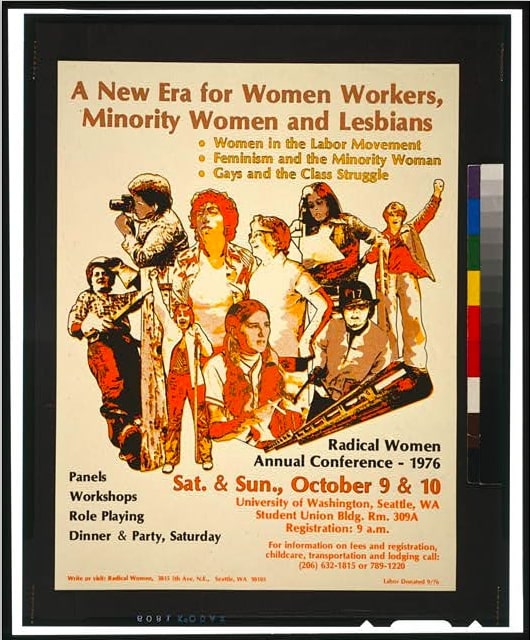 "A new era for women workers, minority women and lesbians" 1976
"A new era for women workers, minority women and lesbians" 1976National Women’s History Museum
FEMINISM : The Second Wave
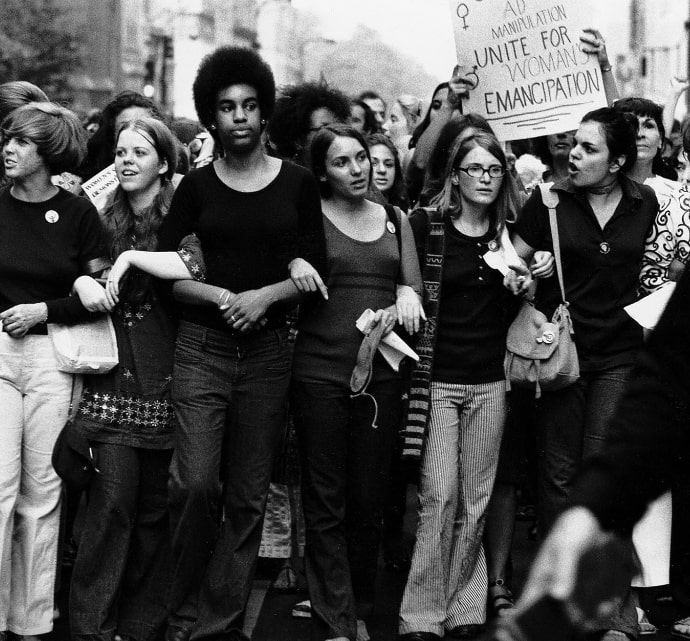 85199 (Sep 1970)
85199 (Sep 1970)by John Olson
LIFE Photo Collection
The Second Wave
After the ratification of the 19th amendment in 1920, which granted women the right to vote, the first wave of feminism slowed down significantly. Although many of these activists continued to fight for women’s rights, the next sustained feminist movement is believed to have started in the 1960s. Much like the first wave that developed during a period of social reform, the second wave also took place amidst other social and political movements.
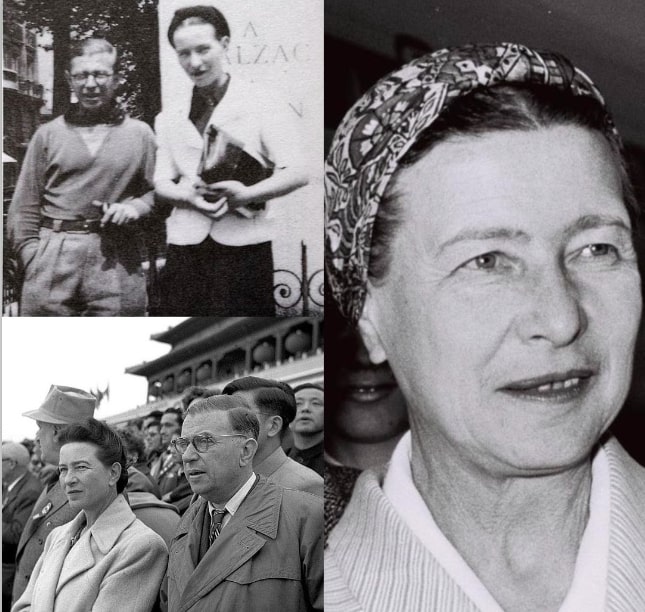 Image Collage: Simone de Beauvoir 1939 - 1967
Image Collage: Simone de Beauvoir 1939 - 1967National Women’s History Museum
The Predecessor
In between the first and the second wave, French feminist author Simone de Beauvoir published a foundational book that set the tone for the next surge of women’s rights activism. Published in 1949, her book entitled “The Second Sex,” provided extensive definitions of womanhood and outlined how women have historically been treated as second to men. Originally published in France, “The Second Sex” quickly became a phenomenon and was published in the United States in 1953. Beauvoir was not only a feminist writer, but she was also considered a philosopher because her writings often answered complex and philosophical questions. In “The Second Sex,” she questions, “What is a woman?” Ultimately, she determined that “one is not born but becomes a woman.
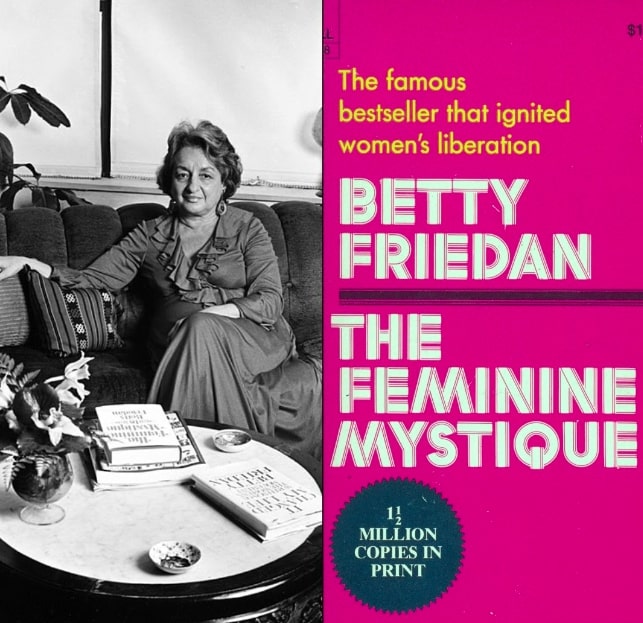 Image Collage: Betty friedan
Image Collage: Betty friedanNational Women’s History Museum
The Instigator
Ten years after “The Second Sex” was published in the United States, American feminist writer Betty Friedan helped ignite the second feminist wave with her book “The Feminine Mystique.” Released in 1963, Friedan builds on the foundation of Simone de Beauvoir’s work. However, Friedan not only employed philosophical thought to discuss feminism, she also incorporated oral histories and her personal experiences to address the issues many women were facing. Friedan first began by researching the role of women in society to see if other women shared her feelings of dissatisfaction and “malaise” as housewives. To her surprise, she was not alone, and her interviews became the source material for her first book.
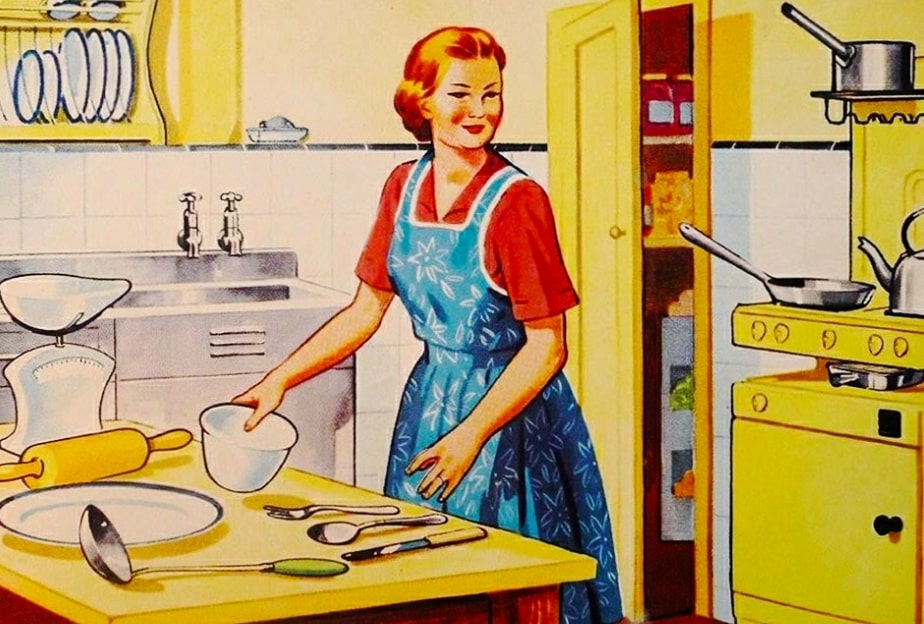 Housewife Cartoon
Housewife CartoonNational Women’s History Museum
In the mid-1950s, Friedan found herself as a stay-at-home housewife after a long career as a journalist, writer, and activist. When she got married and had children, Friedan left her career and moved to the suburbs with her family. Even though she continued writing freelance, she soon realized that she was unhappy solely as a housewife. However, she felt the societal pressure to find ultimate happiness as a mother and a homemaker. In 1957 at her 15-year Smith College reunion, Friedan surveyed her classmates and found that they also were unhappy being confined to the home.
For the next five years, Friedan conducted interviews with white middle-class women who were grappling with their roles as housewives. She published her findings in “The Feminine Mystique,” and instantly became a household name. In her book she criticized the separate “sphere” of motherhood and homemaking that women were relegated to. In contrast, men were allowed to flourish in the “male sphere” of work, politics, and power. Friedan’s book encouraged women to step outside of their “sphere,” and fight gender oppression, which she called “the problem that has no name.”
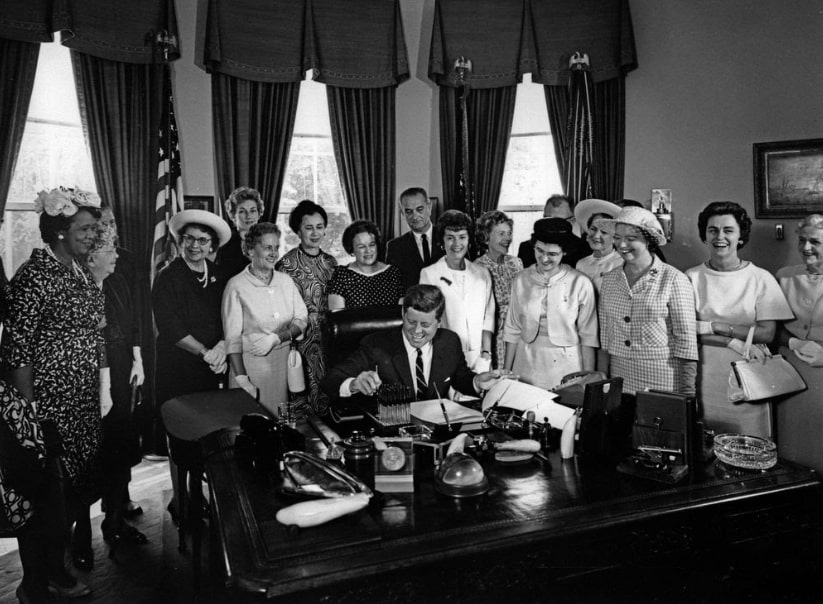 Kennedy 1963
Kennedy 1963Unknown | National Women’s History Museum
The Movement Begins
Friedan’s book sold over three million copies within the first three years and quickly fueled a resurgence of the feminist movement. Middle-class women across the country began to organize to advocate for women’s social and political equality. The same year “The Feminine Mystique” was published, President John F. Kennedy signed the Equal Pay Act of 1963 into law. The new legislation stipulated that women could no longer be paid less than men for doing “comparable work” at the same job. This Act was the result of a group of women in the White House, lead by labor activist Esther Peterson. Peterson was appointed as the head of the Women's Bureau in the Department of Labor in 1961. She convinced President Kennedy to establish a Presidential Commission on the Status of Women to work towards achieving equality. The commission included revolutionary women such as Eleanor Roosevelt and Dorothy Height. After collaborating with the commission, Peterson submitted a draft of the Equal Pay Act to congress on behalf of the Kennedy administration.
“Public service announcement (PSA) informing viewers of their rights under the equal pay law.”
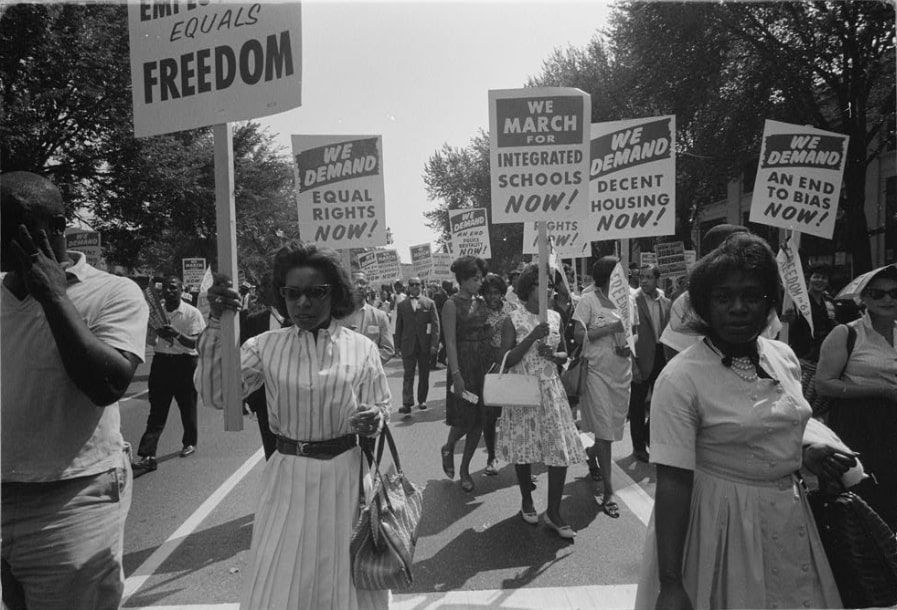 Civil rights march on Washington, D.C. / [WKL].Aug 28, 1963
Civil rights march on Washington, D.C. / [WKL].Aug 28, 1963National Women’s History Museum
Following the Equal Pay Act of 1963, two more legal victories propelled the fight for women’s rights forward. Title VII of the Civil Rights Act of 1964, and the Griswold v. Connecticut Supreme Court ruling of 1965 both secured rights for some feminists and encouraged them to continue to advocate for women’s equality.
Title VII of the Civil Rights Act of 1964 prevented employers from discriminating against employees on the basis of race, religion, sex, or national origin. In addition to the Civil Rights Act, the Griswold v. Connecticut Supreme Court ruling of 1965 prevented anyone from limiting a woman’s access to contraception or other methods of birth control. This case would be used in the famous Roe v. Wade decision, protecting a woman’s right to have an abortion in 1973.
These legal victories gave some women more autonomy in both public and private life. However, many women of color were still disenfranchised.
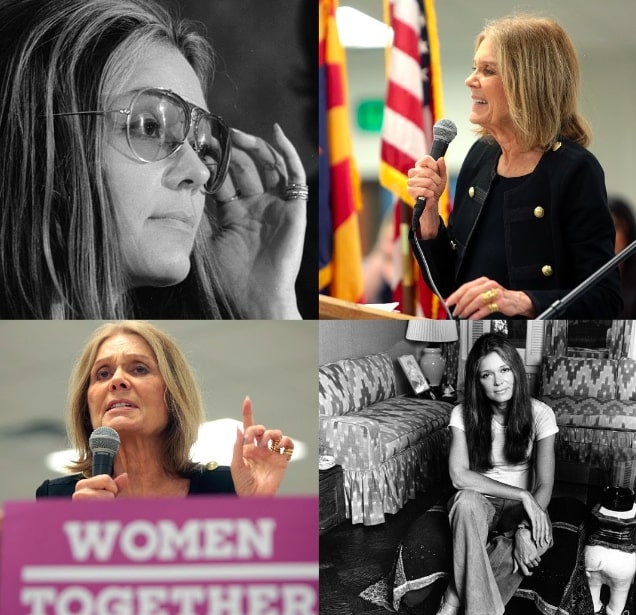 Image Collage: Gloria Steinem 1972 - 2016
Image Collage: Gloria Steinem 1972 - 2016National Women’s History Museum
The Women's Liberation Movement
Early in the second wave, feminist writer Gloria Steinem gained national attention by going undercover as a Playboy Bunny. Her exposé called “A Bunny's Tale,” highlighted the sexism and low wages that women faced in these clubs. Steinem went on to become one of the most recognizable leaders of the second wave. She co-founded both “New York” and “Ms.” magazines and covered political issues ranging from abortion to rape. Steinem first spoke publicly in 1969 at an event to legalize abortion in New York State. Shortly afterwards, she began writing and publishing books that would influence a generation of feminists. Her publications accompanied a host of other feminist work that was published during the period that became the women’s liberation movement. Some of these books include; Kate Millett’s “Sexual Politics” in 1969, Juliet Mitchell’s “The Subjection of Women” in 1970, and Shulamith Firestone’s “The Dialectic of Sex: The Case for Feminist Revolution” in 1970.
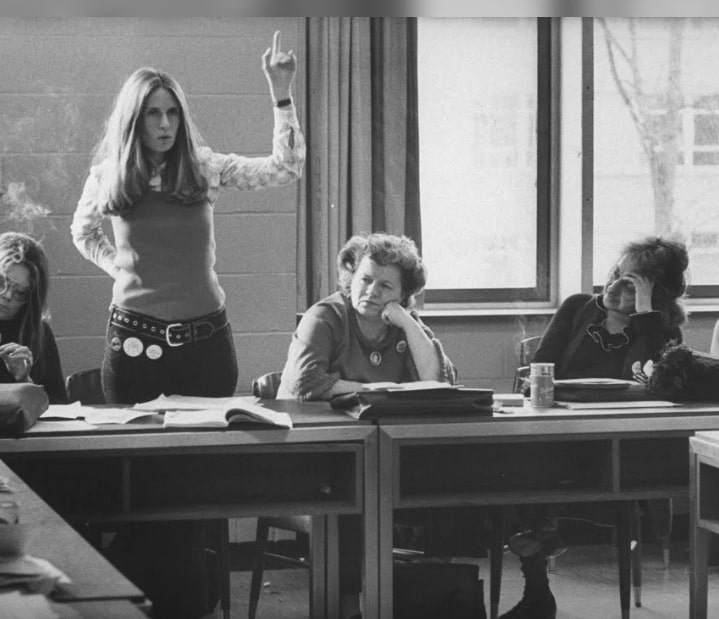 (Jun 1972) by Leonard Mccombe
(Jun 1972) by Leonard MccombeLIFE Photo Collection
In 1972, Steinem teamed up with Betty Friedan and other activists such as Congresswoman Bella Abzug and Congresswoman Shirley Chisholm to form the National Women’s Political Caucus. This caucus was established to support gender equality and ensure proper women’s representation in political office. At the founding meeting, Steinem delivered a speech entitled “Address to the Women of America,” where she called for a women’s revolution.
That same year, the Equal Rights Amendment (ERA) proposed by Alice Paul in 1923 finally passed in Congress. Unfortunately, this amendment guaranteeing equal constitutional rights for women failed to be ratified in 38 states within seven years. Supporters of the ERA continue to fight for it’s ratification today.
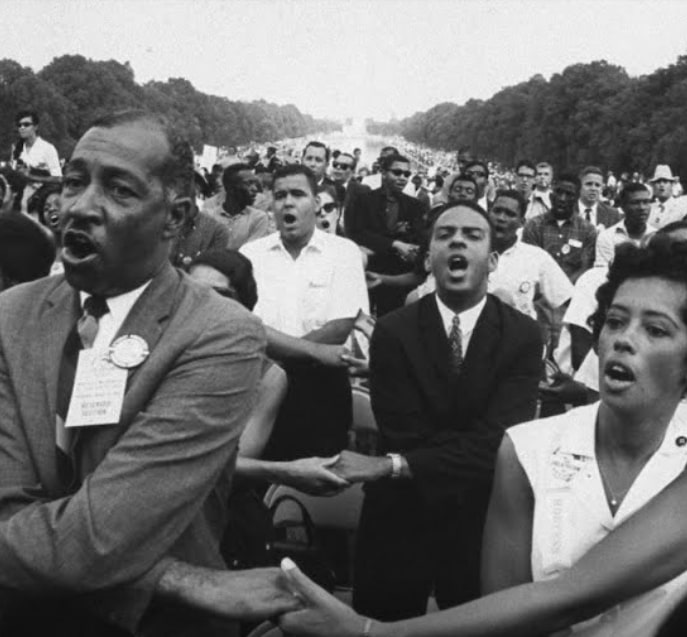 (Aug 1963) by Francis Miller
(Aug 1963) by Francis Miller
The Civil Rights Movement
When the second wave of feminism began, the Civil Rights Movement was already in full swing. After emancipation, African American men and women still had to fight against racism, violence, and segregation to exercise their basic human rights. In addition, even after the ratification of the 19th Amendment ensuring that both men and women were able to vote, African American men and women were still restricted from voting by Jim Crow laws, literacy tests, and grandfather-clauses. As the second surge of feminism grew, African American women were once again fighting for their rights as women, alongside their fight for freedom from racial oppression.
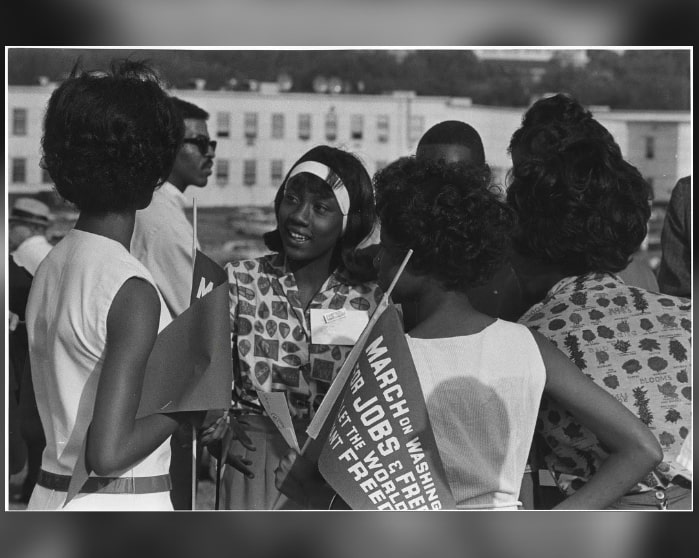 Women at the March
Women at the MarchNational Women’s History Museum
In 1969, Frances M. Beal published “Double Jeopardy: To Be Black and Female,” detailing the experiences of African American women during the feminist movement. Her essay specifically noted the exploitation of black women in society and the different struggles between white and “non-white” feminists.
That same year, Betty Friedan stepped down as president of the organization she co-founded called the National Organization for Women (NOW). Although the organization was racially inclusive, the concerns of black women were frequently sidelined. For example, Friedan and some of the African American members clashed over Friedan’s use of the Civil Rights Act of 1964 to advocate for more jobs for middle-class white women, when many African American men and women faced racially motivated job discrimination and lived below the poverty line. By the time Friedan stepped down in 1969, African American women had already started forming their own feminist organizations.
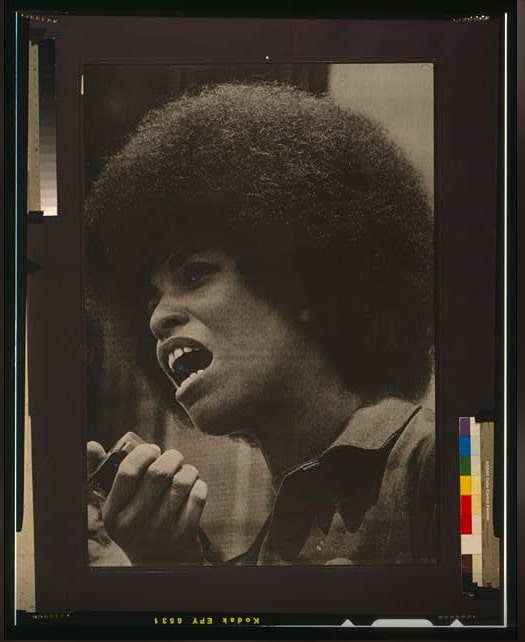 Angela Davis 1965 - 1980
Angela Davis 1965 - 1980National Women’s History Museum
By the 1970s, black women were convening as separate feminist organizations starting with the National Black Feminist Organization (NBFO) in 1973. The Combahee River Collective formed in 1974 for a similar purpose, but they also focused on issues of sexuality that were often left out. Their statement notes, “we are committed to struggling against racial, sexual, heterosexual, and class oppression…” and the way those systems of oppression intersect.
As these women pursued their collective goals, revolutionary scholar and activist Angela Davis began publishing articles and books that would contribute to the foundation of the “Black Feminist” movement. She published an article on the harmful stereotypes of black women in society in 1972 and then followed that with her book entitled, “Women, Race & Class” in 1981. The Combahee River Collective and “Women, Race & Class” both provided a solid foundation for future feminists to study various forms of oppression.
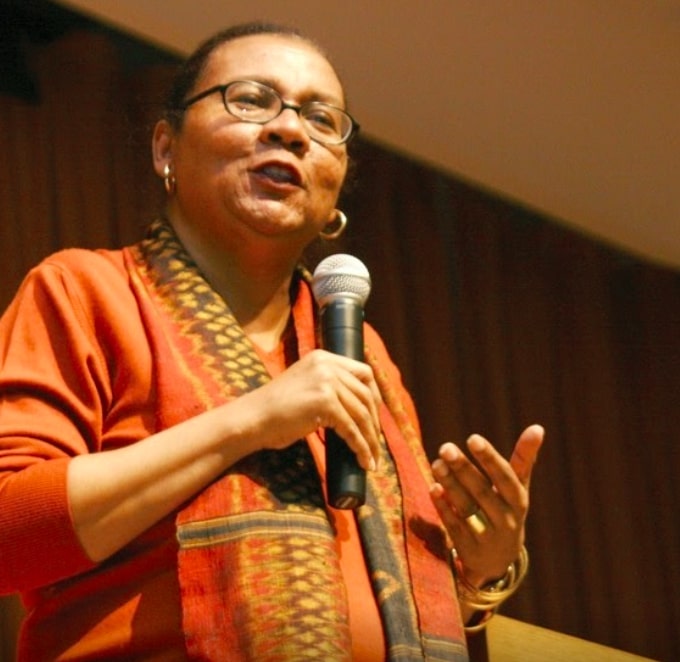 bell hooks (Nov 1, 2009)
bell hooks (Nov 1, 2009)National Women's History Museum
Rethinking Feminism
”Although the women’s movement motivated hundreds of women to write on the woman question, it failed to generate in-depth critical analyses of the black female experience.” --bell hooks in “Ain’t I a Woman: Black Women and Feminism”
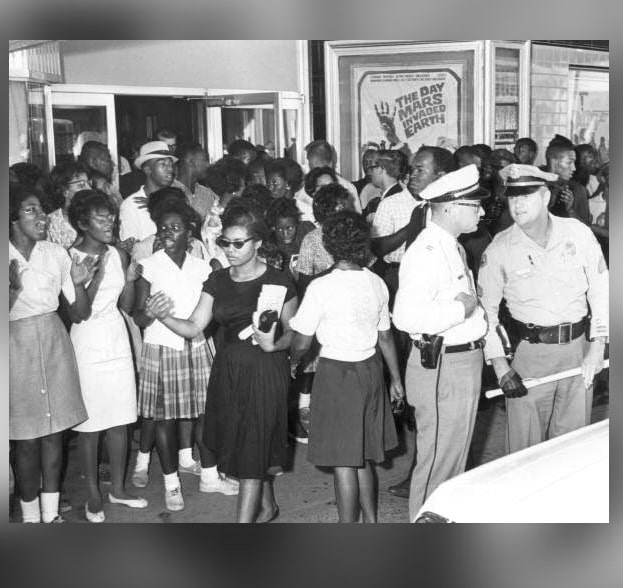 Civil Rights Demonstration
Civil Rights DemonstrationNational Women's History Museum
Also writing in 1981, author Gloria Jean Watkins, known as “bell hooks,” published “Ain’t I A Woman? Black Women and Feminism.” Her book provides an analysis of the current movement and a critique of mainstream feminism for excluding the concerns of black women in their overall fight for equality. Instead, she provides an inclusive method for activism through black feminism. She states, “although the focus is on the black female, our struggle for liberation has significance only if it takes place within a feminist movement that has as its fundamental goal the liberation of all people.”
After her pioneering work, many feminist writings followed that addressed the concerns and activism of women of color. One of these books was “This Bridge Called My Back: Writings by Radical Women of Color” edited by Cherríe Moraga and Gloria E. Anzaldúa in 1981. This work included several writings from black, Native American, Asian American, and Latina women feminists that advocated for their rights in the white-dominated feminist movement.
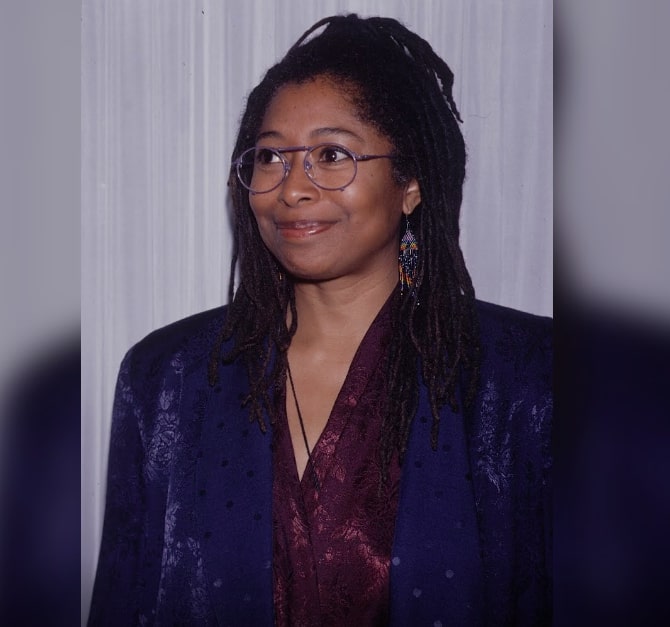 Walker, Alice
Walker, AliceLIFE Photo Collection
Although many African American women identified with hooks’ writing, Alice Walker introduced a new variation of black feminism called “womanism.” Coined by Walker in her 1983 book “In Search of Our Mothers’ Gardens: Womanist Prose,” Walker introduces readers to womanism through a collection of personal and political essays. Developed from the African American cultural significance of the word “womanish,” Walker writes that a womanist is “committed to survival and wholeness of entire people, male and female. Not a separatist, except periodically, for health.”
Womanism is closely aligned with black feminism and many people use the two terms interchangeably. Walker herself notes that the womanist is “a black feminist or feminist of color.” However, Walker also says: “Womanist is to feminist as purple is to lavender.” With this analogy, Walker reminds her audience that there are many different forms and shades of feminism. Walker’s novel “The Color Purple” also became a film directed by Steven Spielberg, featuring Oprah Winfrey and Whoopi Goldberg.
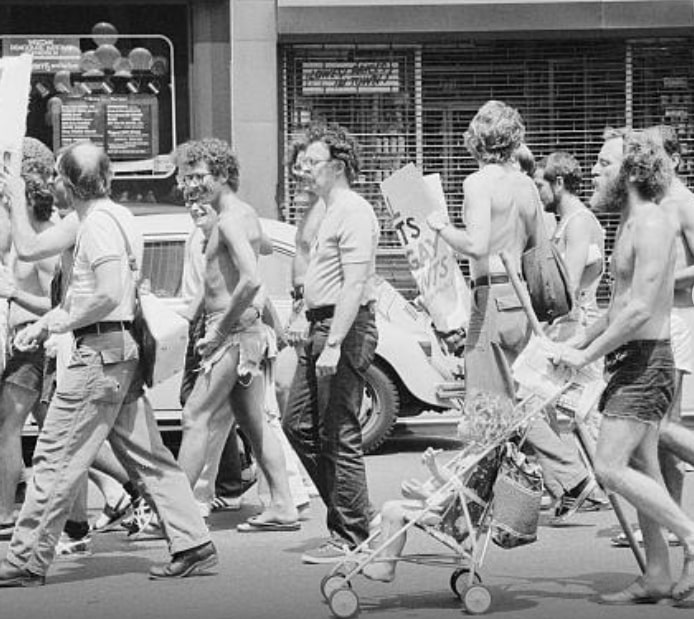 Gay Rights Demonstration (Jul 11, 1976)
Gay Rights Demonstration (Jul 11, 1976)
The Gay Rights Movement
Women of color weren’t the only group fighting for their voice in the larger feminist movement. During the 1960s, the gay rights movement also gained momentum as participants advocated for equal rights and unbiased information about homosexuality. The first gay rights demonstrations were held in Philadelphia and Washington, D.C. as early as 1965. However, the riots at the Stonewall bar in 1969 marked a shift in LGBTQ activism. Starting on June 28, 1969, customers of the Stonewall Inn in New York’s Greenwich Village fought against targeted and frequent police raids.
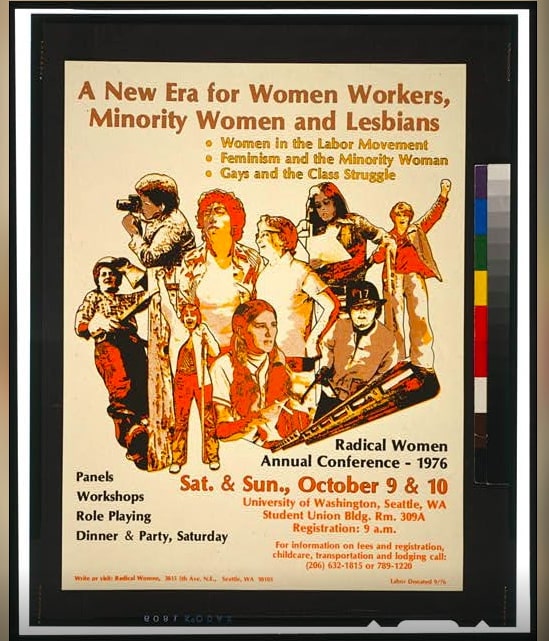 "A new era for women workers, minority women an... (1976)"
"A new era for women workers, minority women an... (1976)"
As the movement progressed, lesbian women had concerns that were not addressed by gay rights activism. Many of these women decided to leave the male leadership of that movement to form their own lesbian organizations. These women advocated for gay rights, as well as feminist rights within organizations like Betty Friedan’s National Organization for Women (NOW). Unfortunately, many of these mainstream feminists rejected their participation. Lesbian women protested their treatment, including a demonstration at the Second Congress to Unite Women in 1970. These women called themselves the “Radicalesbians” and they read their declaration called “The Woman-Identified Woman” to the attendees. The very next year, the NOW adopted a resolution recognizing lesbian rights, and in 1973 they established the NOW Task Force on Sexuality and Lesbianism. Simultaneously, Lesbians of color like Audre Lorde started writing about their particular experiences. Lorde published "Sister Outsider: Essays and Speeches" in 1984.
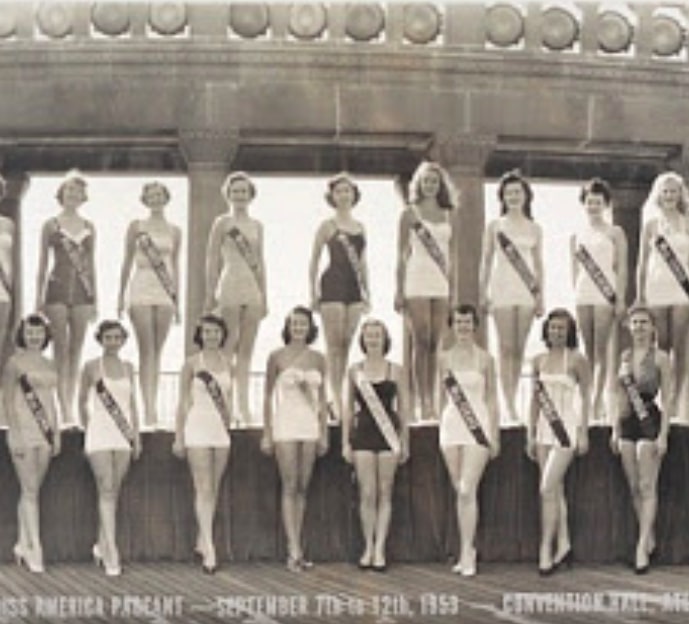
Bra Burning Women
The second wave of the feminist movement is not only known for the tensions between various streams of feminism. This wave is also heavily associated with the “bra-burning” protest of 1968. Although no bra-burning actually occurred, this myth continues to follow the women’s liberation movement. This rumor came from the 1968 Miss America Pageant protest in Atlantic City, New Jersey. On September 7, 1968 a few hundred women interrupted the live broadcast of the Miss America Pageant to protest beauty standards and the objectification of women. These women threw bras, high heels, Playboy magazines, and other symbolic feminine products into a “Freedom Trash Can.” Although the women did not actually ignite a fire, a reporter compared their actions to Vietnam war protesters that would burn their draft cards. This idea of bra-burning feminists followed the movement ever since and contributed to the stereotype of feminists as angry and “man-hating.”
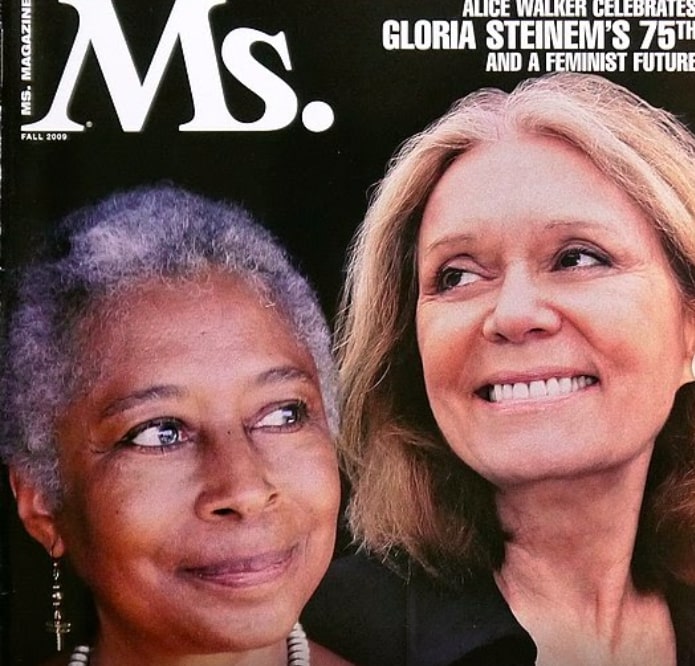 Alice Walker(Left) and Gloria Steinem (right) (2016)
Alice Walker(Left) and Gloria Steinem (right) (2016)by Liberty Media for Women, LLC
National Women's History Museum
By the late 1970s, the second wave of feminism began to lose steam. As multiple sub-groups created new organizations for themselves, other debates within feminism grew. One of the key debates was over pornography and sexual activity. Many feminists decided between being “anti-porn feminists” or “sex-positive feminists.” These debates accelerated an already dwindling larger movement. By the early 1980s, the second wave came to a close and a large-scale feminist movement would not return for another decade.
Credits
Exhibit written and curated by Kerri Lee Alexander, NWHM Fellow 2018-2020
Davis, Angela Yvonne. Women, Race & Class. London: Womens Press, 1986.
D’Emilio, John. “After Stonewall.” Queer Cultures. Eds. Deborah Carlin and Jennifer DiGrazia. Upper Saddle River, NJ: Pearson, 2004. 3-35.
Friedan, Betty. The Feminine Mystique. New York: W.W. Norton & Company, 2013.
Gay, Roxane. “Fifty Years Ago, Protesters Took on the Miss America Pageant and Electrified the Feminist Movement.” Smithsonian.com, January 1, 2018. https://www.smithsonianmag.com/history/fifty-years-ago-protestors-took-on-miss-america-pageant-electrified-feminist-movement-180967504/.
hooks, bell. Aint I a Woman: Black Women and Feminism. New York: Routledge, 2015. Pp. 12
Lee, Jennifer. “Feminism Has a Bra-Burning Myth Problem.” Time Magazine, June 12, 2014. https://time.com/2853184/feminism-has-a-bra-burning-myth-problem/.
Love, Barbara J. Feminists Who Changed America, 1963-1975. University of Illinois Press, 2006.
Morris, Catherine, Rujeko Hockley, Connie H. Choi, Carmen Hermo, and Stephanie Weissberg. We Wanted a Revolution: Black Radical Women, 1965-85: a Sourcebook. Brooklyn, NY: Brooklyn Museum, 2017.
Morris, Bonnie J. “History of Lesbian, Gay, Bisexual and Transgender Social Movements.” American Psychological Association, 2009. https://www.apa.org/pi/lgbt/resources/history.
Walker, Alice. In Search of Our Motherss Gardens: Womanist Prose. San Diego: Harvest, 1984. Pp. xii
